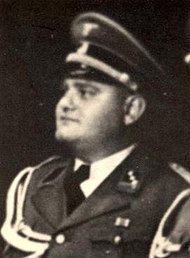| Dieter Wisliceny | |
|---|---|
 | |
| Born | Dietrich Wisliceny 13 January 1911 (1911-01-13) Estate Regulowken near Mosdzehnen, Kreis Angerburg, Province of East Prussia, Kingdom of Prussia, German Empire |
| Died | 4 May 1948 (1948-05-05) (aged 37) Bratislava, Czechoslovakia |
| Cause of death | Execution by hanging |
| Criminal status | Executed |
| Conviction(s) | Crimes against humanity |
| Criminal penalty | Death |
| Military career | |
| Allegiance | |
| Service | |
| Years of service | 1931–1945 |
| Rank | SS-Hauptsturmführer |
| Unit | SS-Totenkopfverbände |
| Relations | Günther-Eberhardt Wisliceny (brother) |
Dietrich "Dieter" Wisliceny (13 January 1911 – 4 May 1948) was a member of the Schutzstaffel (SS) and one of the deputies of Adolf Eichmann, helping to organise and coordinate the wide scale deportations of the Jews across Europe during the Holocaust.
Life
Dieter was born in 1911 as the son of the lord of the manor (Rittergut Regulowken) Erich Wisliceny (d. 1928) and his wife Wally, née Paul, in East Prussia. In 1919, after losing the estate, the family moved to Silesia.
After graduating from Gymnasium in Breslau, Wisliceny began studying theology in 1930 at the University of Breslau, but dropped out after one semester.
On 1 October 1931, Wisliceny became a member of the NSDAP and of a formation of the SA. In 1934, he switched from the SA to the SS and became a member of the SD. Wisliceny eventually rose to the rank of SS-Hauptsturmführer (captain) in 1940; he worked in the Reich Security Head Office Referat IV B4 under Adolf Eichmann.
During implementation of the Final Solution, his task was the ghettoization and liquidation of several important Jewish communities in Nazi-occupied Europe, including those of Greece, Hungary and Slovakia. Wisliceny also re-introduced the yellow star in occupied countries; the yellow star being used to distinguish Jews from non-Jews.
Wisliceny was an important witness at the Nuremberg trials. His testimony would later prove important in the successful prosecution of Eichmann for his complicity in the Holocaust in Israel in 1961.
Death
Wisliceny was extradited to Czechoslovakia, where he was tried and hanged for war crimes in 1948.
Awards and decorations (excerpt)
- Honour Chevron for the Old Guard
- Honour Sword of the Reichsführers-SS
- Danzig Cross, 2nd Class
- NSDAP Long Service Award in Bronze (10 years)
- SS Long Service Award, 3rd Grade (8 years) in 1942
- War Merit Cross (1939), 2nd Class with Swords
References
- Prof. Stuart Stein (1946). "Affidavit of Dieter Wisliceny". Nazi Conspiracy and Aggression. VIII. United States Government Publishing Office: 606–619. Archived from the original on 2007-08-10.
Dieter Wisliceny in his testimony given before the International Military Tribunal at Nuremberg, 3 January 1946, erroneously identifies the Auschwitz concentration camp as the concentration area Sosnowitz (which was one of its dozens of subcamps)
.
External links
- "Nuremberg testimony of Dieter Wisliceny". Nizkor Project. 2012. Retrieved 3 September 2016.
| The Holocaust in Slovakia | |||||
|---|---|---|---|---|---|
| |||||
| Camps and prisons | |||||
| Massacres and roundups | |||||
| Major perpetrators |
| ||||
| Jewish Center | |||||
| Rescuers | |||||
| Aftermath | |||||
| Related articles | |||||
| The Holocaust in Ukraine | |||
|---|---|---|---|
| People | |||
| Organizations |
| ||
| Events | |||
| Places | |||
| Evidence | |||
| Trials | |||
| Books, films | |||
- 1911 births
- 1948 deaths
- People from Giżycko County
- People from East Prussia
- SS-Hauptsturmführer
- Reich Security Main Office personnel
- Holocaust perpetrators in Greece
- Holocaust perpetrators in Poland
- Holocaust perpetrators in Slovakia
- Holocaust perpetrators in Ukraine
- People extradited to Czechoslovakia
- Nazis convicted of war crimes
- Nazis executed by Czechoslovakia by hanging
- Executed German mass murderers
- Witnesses to the International Military Tribunal in Nuremberg